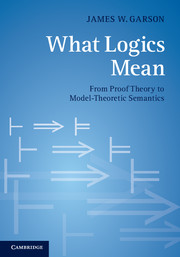Book contents
- Frontmatter
- Dedication
- Contents
- Preface
- Acknowledgements
- 1 Introduction to model-theoretic inferentialism
- 2 Deductive expression
- 3 Local expression
- 4 Global expression
- 5 Intuitionistic semantics
- 6 Conditionals
- 7 Disjunction
- 8 Negation
- 9 Supervaluations and natural semantics
- 10 Natural semantics for an open future
- 11 The expressive power of sequent calculi
- 12 Soundness and completeness for natural semantics
- 13 Connections with proof-theoretic semantics
- 14 Quantifiers
- 15 The natural semantics of vagueness (with Joshua D. K. Brown)
- 16 Modal logic
- Summary
- References
- Index
Summary
Published online by Cambridge University Press: 05 June 2014
- Frontmatter
- Dedication
- Contents
- Preface
- Acknowledgements
- 1 Introduction to model-theoretic inferentialism
- 2 Deductive expression
- 3 Local expression
- 4 Global expression
- 5 Intuitionistic semantics
- 6 Conditionals
- 7 Disjunction
- 8 Negation
- 9 Supervaluations and natural semantics
- 10 Natural semantics for an open future
- 11 The expressive power of sequent calculi
- 12 Soundness and completeness for natural semantics
- 13 Connections with proof-theoretic semantics
- 14 Quantifiers
- 15 The natural semantics of vagueness (with Joshua D. K. Brown)
- 16 Modal logic
- Summary
- References
- Index
Summary
It is time to draw this book to a close, and to reflect on what has been accomplished. I hope its main contribution will be to spark future research on what logics mean. So far, only a few excursions have been taken in a vast landscape of questions about natural semantics and its philosophical applications. A handful of answers have been given to the main question that is posed by this book, namely how or whether inferential rules governing an expression fix its truth conditions. However, we have just scratched the surface. For example, more needs to be done to fully understand classical quantification. Results for free logics and systems for generalized quantifiers have not even been attempted. Exploring rules in the logic programming tradition and the concept of negation as failure could be very fruitful. Modal logics and their quantified extensions are also promising territory for new results, to say nothing of tense logics, multi-modal logics, dynamic logic, and inquisitive logic. Despite the fact that natural semantics seems wedded to standard structural rules, it is still possible to obtain some results for relevance logic (Garson, 1990, Section 5). Modifications to the definition of validity mentioned in Section 16.5 promise to allow application of the ideas of natural semantics to a wider range of systems including substructural logics. Function symbols, descriptions, the lambda calculus, set theory, and arithmetic all remain to be explored. Furthermore, there is no reason why natural semantics has to be limited to the domain of logic. The inferential roles set up within a natural language provide a much richer field of investigation. There promise to be a wide range of applications to philosophical problems as well, at the very least to areas such as truth paradoxes and presupposition where supervaluations have been deployed in the past.
Given results obtained so far, what conclusions should be drawn concerning model-theoretic (MT) inferentialism? Those of an intuitionist persuasion may take heart at the fact that the rules for conjunction, the conditional, and intuitionistic negation express exactly their intuitionistic readings in Kripke semantics. Furthermore, if the position taken in Section 8.9 is adopted, one will conclude that the reading of the rules for classical negation is intuitionist as well.
- Type
- Chapter
- Information
- What Logics MeanFrom Proof Theory to Model-Theoretic Semantics, pp. 271 - 274Publisher: Cambridge University PressPrint publication year: 2013



